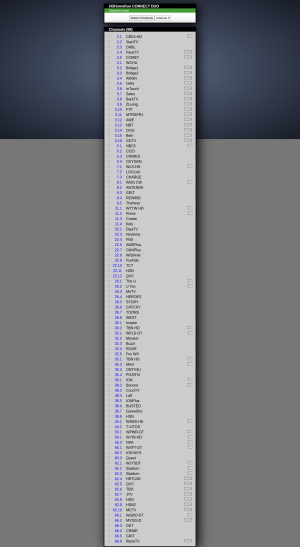Getting a deluge of antenna advertisements as I surf the web lately.
Most of the advertisements state that the antennas are ATSC 3.0 (NextGen TV) compatible.
AI Overview:
ATSC 3.0, also known as NextGen TV, is a new standard for over-the-air broadcasting that offers improved picture quality, immersive audio, and more robust signals for both fixed and mobile devices. To watch it, you need a new television with the "NEXTGEN TV" logo or an external tuner, as older ATSC 1.0 TVs cannot decode the new signals. While it promises features like interactive content and advanced emergency alerts, its adoption has been complicated by issues like DRM encryption and patent disputes, which can increase costs and limit functionality like DVR recording.
Key benefits of ATSC 3.0
Better viewing experience: Offers a higher-quality picture, including support for up to 4K, with advanced high dynamic range (HDR) and immersive, multi-dimensional sound like Dolby Atmos.
Improved reception: Provides a more robust signal that is often clearer, with less buffering and fewer dropouts, even in challenging conditions.
Mobile and interactive features: Broadcasts can be received on mobile devices like phones and in cars, and the standard supports interactive content, personalized programming, and advanced emergency alerts.
Integration of content: Aims to combine traditional over-the-air broadcast with on-demand and internet-based content.
What you need to watch ATSC 3.0
A new TV or converter box: Your current ATSC 1.0 TV is not compatible. You must have a newer television with the "NEXTGEN TV" logo or purchase a separate ATSC 3.0 converter box.
An existing antenna: You can use your current over-the-air antenna, as it will work for ATSC 3.0 signals.
Important considerations
DRM encryption: Many broadcasters are using Digital Rights Management (DRM) to encrypt their ATSC 3.0 signals. This can prevent commercial skipping, limit DVR functionality, and even make it impossible to record certain programs.
Cost and compatibility: The need to support DRM can significantly increase the cost of ATSC 3.0-enabled TVs and tuners. Also, fewer devices currently support the necessary software to decode the encrypted channels.
Limited 4K: While the standard supports 4K, most current ATSC 3.0 broadcasts are 1080p or 720p, which are then upscaled.
Longer channel tuning times: It may take significantly longer for an ATSC 3.0 channel to load compared to a traditional ATSC 1.0 channel.
None of the advertisments state that you need an ATSC 3.0 tuner. The new TV here does recieve ATSC 3.0. None of the HDHomerun boxes I have receive ATSC 3.0.
ATSC 3 Update - "High Noon" : A secret broadcaster plan to take over the public airwaves
My sister's father in law and mother in law worked for Weigel Broadcasting. I helped him some switching stuff over to the Amiga Toaster many many years ago. When I toured the station (in the 1990's) most of the equipment being utilized was from the 1960's.
Weigel Broadcasting was very reluctant to upgrade to ATSC 1.
During the conversion to ATSC 1.0 (digital television), both broadcasters and consumers bore the costs.
Broadcasters paid for new transmission equipment
Television stations were responsible for upgrading their infrastructure, which included purchasing and installing new digital transmitters and antennas.
While there was some federal funding available to help public television stations with this transition, broadcasters generally paid for their own upgrades.
Consumers paid for new receiving equipment
Consumers needed new equipment to receive the digital broadcasts. This was paid for in two ways:
New televisions: Consumers who purchased new television sets after the transition began bought models with built-in digital tuners. The cost of this equipment was reflected in the price of the TV.
Converter boxes: Those who wished to keep their older analog televisions purchased a digital-to-analog converter box. The U.S. government provided a subsidy program to help households purchase these boxes.


